-
Paper Information
- Next Paper
- Previous Paper
- Paper Submission
-
Journal Information
- About This Journal
- Editorial Board
- Current Issue
- Archive
- Author Guidelines
- Contact Us
International Journal of Psychology and Behavioral Sciences
p-ISSN: 2163-1948 e-ISSN: 2163-1956
2011; 1(1): 9-17
doi: 10.5923/j.ijpbs.20110101.02
Implicit Preconceptions of Male and Female Intelligence in Contemporary Russia
Victoria A. Dessau , Irina A. Mironenko
Department of Psychology and Communication Disorders, State Pushkin University, St. Petersburg, 196605, Russia
Correspondence to: Irina A. Mironenko , Department of Psychology and Communication Disorders, State Pushkin University, St. Petersburg, 196605, Russia.
| Email: |  |
Copyright © 2012 Scientific & Academic Publishing. All Rights Reserved.
Investigation revealed implicit preconceptions of Male and Female Intelligence in contemporary Russian society. A substantial difference in the structure and constituting elements between the representations was shown. It was shown also that preconceptions of Male and Female Intelligence are substantially different for male and for female samples. A two-stage procedure was used. At the first stage our subjects freely described Male and Female intelligence and at the second stage we used two sets of rating scales. One of them was a set for personality traits (Personality Semantic Differential) and another one was specially constructed of nine scales for evaluating cognitive abilities.
Keywords: Implicit Theories, Lay Theories of Intelligence, Wisdom, Gender Stereotypes, Gender Differences in Intelligence Estimates, Male and Female Intelligence
Cite this paper: Victoria A. Dessau , Irina A. Mironenko , "Implicit Preconceptions of Male and Female Intelligence in Contemporary Russia", International Journal of Psychology and Behavioral Sciences, Vol. 1 No. 1, 2011, pp. 9-17. doi: 10.5923/j.ijpbs.20110101.02.
Article Outline
1. Introduction
- Few topics in psychology are as popular as gender differences in intelligence and related issues are seldom out of attention both of academics and broad public.There is a general "academic consensus for many years to the effect that actual differences between the sexes are minimal" [1, p. 513]. The dominating view is that "the sex difference in psychometric g is either totally non-existent or is of uncertain direction and inconsequential magnitude" [2, p. 540].Nevertheless, studies on lay theories of intelligence show consistent differences[3-7]. Moreover, there is a lot of evidence that at the level of everyday perception intellectuality is a masculine characteristic[4-9]. Also a lot of data show that these differences are culture biased[1,6,10-13].Our research was aimed to investigate gender differences in lay theories of intelligence in contemporary Russian society. The investigation was designed in order to explore implicit preconceptions of Male and Female Intelligence.We used a two-stage procedure, so that the results of the first stage experiment were employed for the design of the second stage. At the first stage our subjects were asked to write down as many characteristics of Male Intelligence and then of Female Intelligence as possible. So they described Male and Female Intelligence freely. At the second stage rating scales and semantic differential technique were used.358 subjects were involved. All of them were residents of St.Petersburg(Russia), adults, aged 20 to 45, including 105 men(26 years old on average) and 253 women(29 years old on average).
2. Experiment 1
- At the first stage our subjects freely described Male and Female Intelligence.
2.1. Method
- At this stage of investigation respondents were asked to write down as many features of Male and then Female Intelligence as possible ("free responses").The resulting data contained nearly 1500 words which reflect qualities of Male and Female Intelligence as perceived by our respondents. Afterwards the data were subjected to content analysis and further on to cluster analysis.
2.2. Data Analysis
- Coding process was used which ended in grouping of words with similar meaning into descriptive categories, which resulted in 32 categories. Then each of them was given a title and a definition. Once the categories were identified, the frequency of each category was crossed with respondents’ belonging to the male or female part of the sample.At this stage we considered inverse categories separately (Friendliness and Hostility; Extraversion and Unsociability; etc.).
2.3. Results and Discussion
- It should be noted that among the resulting categories we have found not only those applicable to cognitive processes, but also the qualities which are usually referred to as personality traits: Decisiveness, will power; Refinement; Extraversion; Sense of humor; etc. Among the characteristics ascribed to intelligence we have detected not only those which are usually regarded as positive features but negative as well, usually attributed to the opposite sex: Hostility, Stupidity, Recklessness.The results revealed existence of some characteristics which were mentioned by the majority of our respondents while describing both Male and Female Intelligence: Extraversion; Friendliness; Decisiveness, will power; Emotional stability; Refinement and culture; Ability to understand and predict others; Logic, common sense; Using knowledge in practice; Knowledge of life, as shown in Table 1 (results given in % from the total number of respondents).
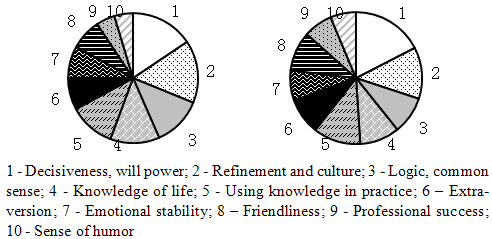 | Figure 1. Perceived structure of Male Intelligence. |
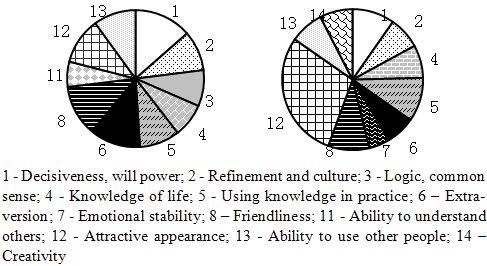 | Figure 2. Perceived structure of Female Intelligence. |
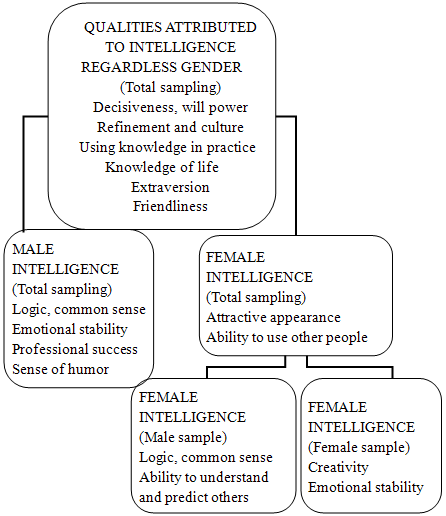 | Figure 3. Implicit preconceptions of Intelligence. |
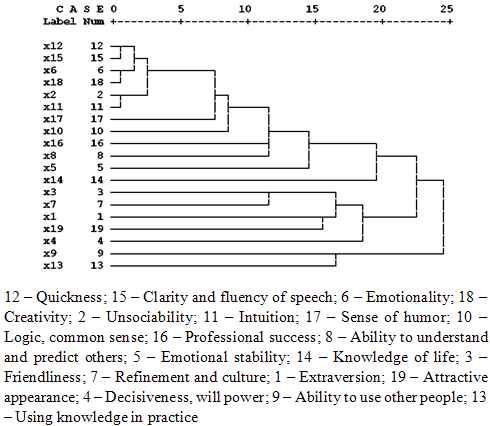 | Figure 4. Structure of Female Intelligence (female sample). |
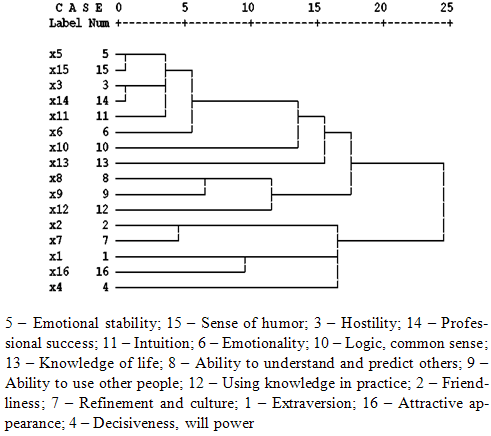 | Figure 5. Structure of Female Intelligence (male sample). |
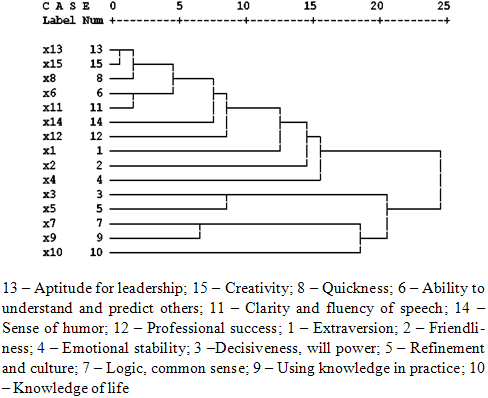 | Figure 6. Structure of Male Intelligence (male sample). |
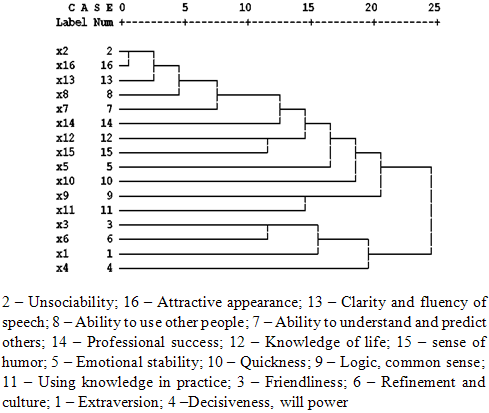 | Figure 7. Structure of Male Intelligence (female sample). |
3. Experiment 2
- In the second experiment we use rating procedure which was based on the results of the first experiment.
3.1. Method
- We chose two sets of 7-point rating scales. First set for 21 personality features, well adapted to Russian sample and widely used under the name "Personality Semantic Differential" (PSD) [14]. The second one was specially constructed for evaluating cognitive abilities. It includes the following 7-points scales: Using knowledge in practice; Clarity and fluency of speech; Ability to coordinate various points of view; Quest for information; Knowledge of life; Quick wits, abstract thinking; Ability to understand and predict others; Cunning; Ability to use other people.To shed some new light upon the question of personality features associated with Male and Female Intelligence our subjects were asked to evaluate personality features attributed to Clever Man and Clever Woman using the PSD scales.Then they were asked to evaluate intellectual abilities of Clever Man (CM), Clever Woman (CW), Ordinary Man (OM) and Ordinary Woman (OW) using the PSD set of rating scales. We considered necessary to use these four personages for investigating lay conceptions of Male and Female intellect because we supposed that there might be differences in commonsense theories concerning the distribution of cognitive abilities between the male and female samples. So that Clever and Ordinary persons could be more or less different one from another. That might give us some additional information.
3.2. Data Analysis
- The data obtained were processed by methods of descriptive statistics, analysis of the statistical significance of differences, and methods of correlation and factor analysis.
3.3. Results and Discussion
- Analysis of the results of evaluating of Male and Female Intelligence as ascribed to Clever Man and Clever Woman for the total sampling revealed statistically significant differences in concern of some cognitive abilities in the structure of Male and Female Intelligence (see Table 2).Male Intelligence is credited with a greater capacity of Using knowledge in practice. Female is superior about the last three parameters listed in the inventory, which can be attributed to the sphere of social intelligence.Implicit representations of Male and Female Intelligence differ substantially for male and female samples. It is noteworthy that there is no cognitive ability in which men would recognize the superiority of women! Men take credit for excellence in Using knowledge in practice, Ability to coordinate various points of view, Knowledge of life and Quick wits, abstract thinking. They also deny the superiority of women in relation to the "social" skills. Women recognize the priority of men in the Using knowledge in practice, but consider the difference less pronounced than the total sampling. In addition, women tend to see female's superiority in regard to "social" parameters as more substantial in comparison with the data for the total sampling. It should be noted that Quick wits, abstract thinking women suppose to be significantly more manifested in Female Intelligence, while the male sample regards Male Intelligence superior in this respect.
| ||||||||||||||||||||||||||||||||||||||||||||||||||||||||||||||||||||||||||||||||||||||
| ||||||||||||||||||||||||||||||||||||||||||||||||||||||||||||||||||||||||||||||||||||||
| ||||||||||||||||||||||||||||||||||||||||||||
| ||||||||||||||||||||||||||||||||||||||||||||||||||||||||||||||||||||||||||||||||||||||||||||||||||||||||||||||||||||||||||||||||||||||||||||||||||||||||||||||||||||||||||
| ||||||||||||||||||
4. Conclusions
- Our investigation revealed implicit preconceptions of Male and Female Intelligence in contemporary Russian society. A substantial difference in the structure and constituting elements between the representations was shown. It was shown also that the preconceptions of Male and Female Intelligence are substantially different for male and for female samples.Using factor analysis method, separately for men’s answers and women’s answers, we exposed and described the structure of lay preconceptions of Male and Female Intelligence. It was shown that alongside with common factors there exist specific ones as well, that define the structure of lay preconceptions of Male and Female Intelligence for male and for female sampling. Two common factors were detected for the respondents of both genders: "Ingenuousness, Simple-mindedness – Slyness, Cunning" and"Маchiavellism". When analyzing the women’s answers, we detected factors not present in the male sample: "Wisdom, Understanding of Life – Vanity. Feminine Aspects of Wisdom" and "Superficiality, shallow mind – Deep mind. Masculine Aspects of Wisdom ". Analysis of male sample answers did not reveal similar factors. Instead a specific factor was exposed, which we interpreted as "Clever woman as Anomaly". The reason for that might be culture biased and perhaps interrelated with the fact that our results revealed the absence of a generally known tendency to lower self-esteem of intellectual abilities for women[4,5]. In contrast a marked tendency for female sample to evaluate Female Intelligence in all its’ aspects and functions superior to the Male Intelligence was discovered. This tendency is particularly manifest in comparison of evaluations of cognitive abilities of Ordinary Woman and Ordinary Man, less striking was the difference between evaluations of abilities of Clever Man and Clever Woman. It’s noteworthy that the facts exposed are consistent with the results of the research of self-evaluations of intellectual abilities of women in Slovakia[18], where woman awarded themselves higher overall scores on intellectual abilities, in contrast to other European woman. We agree that: "…it may well be that under the pressure of socialist governments of Eastern Europe the role of females in society was somewhat different from that in capitalist Western Europe, where they took a more active role in the economy and were socialized differently in school" [18, p. 137]. We suppose also that this tendency to a large degree is due to the tradition of a very active and even leading role that women played in the family life in Russia in the second half of the 20th century[19] and also due to massive propaganda of equal rights and abilities of men and women of the Soviet period[20].
References
| [1] | Furnham, A., 2000, Thinking about intelligence. The Psychologist, 13(10), 510-514 |
| [2] | Jensen, A., 1998, The g factor: The science of mental ability. Westport, CT: Praeger |
| [3] | Furnham, A., Clark, K., & Bailey, K., 1999, Sex differences in estimates of multiple intelligences. European Journal of Personality, 247–259 |
| [4] | Furnham, A., 2005, Gender and Personality Differences in Self- and Other Ratings of Business Intelligence. British Journal of Management, 16, 91–103 |
| [5] | Furnham, A., Crawshaw, J., & Rawles, R., 2006, Sex Differences in Self-Estimates on Two Validated IQ Test Subscale Scores. Journal of Applied Social Psychology, 36: 417–440. |
| [6] | Rammstedt, B., & Rammsayer, T. H., 2002, Gender differences in self-estimated intelligence and their relation to gender-role orientation. European Journal of Personality, 16, 369–382 |
| [7] | Sternberg, R. J., 2003, Contemporary Theories of Intelligence. Handbook of Psychology, 21–45 |
| [8] | Boddice, R., 2011, The Manly Mind? Revisiting the Victorian "Sex in Brain" Debate. Gender & History, 23, 321–340 |
| [9] | Dustin B. Thoman, Paul H. White, Niwako Yamawaki and Hirofumi Koishi, 2010, Variations of Gender–math Stereotype Content Affect Women’s Vulnerability to Stereotype Threat. Sex Roles, Volume 58, Numbers 9-10, 702-712 |
| [10] | Azuma, H., & Kaschiwagi, K., 1987, Descriptors for an intelligent person: A Japanese Study. Japanese Psychological Research, 29, 17–26 |
| [11] | Miguel, I., Pires Valentim, J., Carugati, F., 2010, Intelligence and its development: Social representations and social identities. Papers on Social Representations, 19, 20.1-20.33 [Online]. Available: http://www.psych.lse.ac.uk/psr |
| [12] | Roets, A., Van Hiel, A. and Dhont, K., 2011, Is Sexism a Gender Issue? A Motivated Social Cognition Perspective on Men's and Women's Sexist Attitudes Toward Own and Other Gender. European Journal of Personality. doi: 10.1002/per.843 |
| [13] | Swami, V., Furnham, A., Maakip, I., Ahmad, M. S., Nawi, N. H. M., Voo, P. S. K., Christopher, A. N. and Garwood, J., 2008, Beliefs about the meaning and measurement of intelligence: a cross-cultural comparison of American, British and Malaysian undergraduates. Applied Cognitive Psychology, 22: 235–246 |
| [14] | Fetiskin, N.P., Kozlov, V.V., & Manujlov, G.M., 2005, Socio-psychological diagnostics of personality development and small groups (in Russian). Moscow, Russia: Institute of Psychotherapy |
| [15] | Ardelt M., 2009, How Similar are Wise Men and Women? A Comparison Across Two Age Cohorts. Research in Human Development, 6 (1), Special Issue: Gender and Wisdom, 9-26 |
| [16] | Glück J, Strasser I. & Bluck S., 2009, Gender Differences in Implicit Theories of Wisdom. Research in Human Development, 6 (1), Special Issue: Gender and Wisdom, 27-44 |
| [17] | Levenson, M., 2009, Gender and Wisdom: The Roles of Compassion and Moral Development. Research in Human Development, 6 (1), Special Issue: Gender and Wisdom, 45-59 |
| [18] | Furnham, A., Rakow, T., Sarmany-Schiller, & De Fruyt, F., 1999, European differences in self-perceived multiple intelligences. European Psychologist, 4, 131–138 |
| [19] | Druzhinin, V.N., 2005, Psychology of Family Relations (in Russian). St.Petersburg, Russia: Piter |
| [20] | Kletzyna, I.S., 2004, Psychology of Gender Relations (in Russian). Rusia, St.Petersburg: Aleteja |
 Abstract
Abstract Reference
Reference Full-Text PDF
Full-Text PDF Full-Text HTML
Full-Text HTML